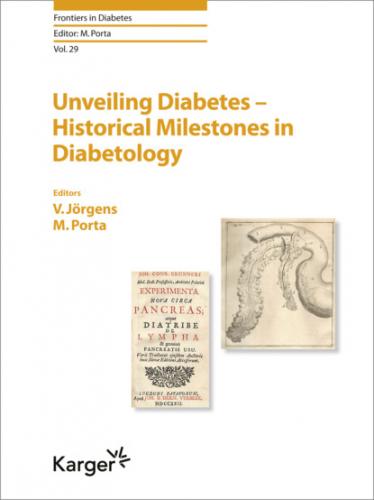4Bernard C: Chiens rendus diabétiques. C R Soc Biol 1849;1:60.
5Bernard C: Influence du systhème nerveux sur la production du sucre dans l’économie animale. Bull Soc Phil 1849:49–51.
6Bernard C: Introduction à l’Étude de la Médecine Expérimentale. Paris, Baillière, 1865.
7Bernard C: Leçons sur les Phénomènes de la Vie Communs aux Animaux et aux Végétaux. Paris, Baillière, 1878, 1879.
8Bernard C: Leçons sur le diabète et la glycogènese animale. Paris, Baillière, 1877.
9Grmek MD: Le legs de Claude Bernard. Paris, Librairie Arthème Fayard, 1997.
Dr. Viktor Jörgens
Fuhlrottweg 15
DE–40591 Düsseldorf (Germany)
Jörgens V, Porta M (eds): Unveiling Diabetes - Historical Milestones in Diabetology. Front Diabetes. Basel, Karger, 2020, vol 29, pp 25–35 (DOI: 10.1159/000506551)
______________________
Paul Langerhans: The Man Who Discovered the Islets
Viktor Jörgens
Executive Director EASD/EFSD 1987–2015, Düsseldorf, Germany
______________________
Abstract
The name Paul Langerhans will, forever, be associated with two discoveries that he made: the islets of Langerhans in the pancreas and the cells he discovered in the skin. Working in the laboratory of Prof. Rudolf Virchow, in Berlin, Langerhans characterized for the first time the islets of Langerhans in his 1869 medical thesis. Yet, what most diabetologists tend to ignore, is the fact that he was also the first to describe the “dendritic cells” in the suprabasal region of the epidermis. These cells were first identified and reported by Paul Langerhans in 1896. These Langerhans cells in the skin received much attention in allergy research from 1973 onwards. They play an important role in the pathophysiology of immune reactions, not only in the skin. Thus, Paul Langerhans, during his last year of undergraduate studies in the laboratory of Rudolf Virchow in Berlin, made his name immortal in medical history not once, but twice.
© 2020 S. Karger AG, Basel
Prof. Björn M. Hausen, who was a renowned expert in allergology and published an outstanding biography on Paul Langerhans, died in 2017. This article is based upon his work with the permission of his widow.
Paul Wilhelm Heinrich Langerhans was born in Berlin on July 25, 1847. His father, Dr. med. Paul August Herrmann Langerhans (1820–1909), had been practicing medicine in Berlin since 1842. His mother was Anna Louise Caroline Langerhans, born Keibel (1824–1853). Dr. H. Morrison, who researched Langerhans for an introductory essay [1], believed her to be a cousin of the Histologist Franz Keibel (1861–1929). Björn Hausen discovered that their great-grandfathers were brothers. The Langerhans family lived in Berlin at Köpenickerstrasse 111 in the eastern part of the city – the house was destroyed in World War II and was subsequently replaced by an East German prefabricated building.
On October 5, 1853, Anna Langerhans died of tuberculosis. She was 29 years old at the time of her passing and Paul was just 6 years old. In later years, despite the discoveries of Robert Koch proving otherwise, Paul continued to believe that tuberculosis was a hereditary condition because himself, his mother, and his brother each became victims of this bacterial disease.
Fig. 1. Watercolor by Paul Langerhans: The island of Usedom, where the Langerhans family spent the holidays, about 1863 [9].
His father remarried 2 years after Anna’s passing, and luckily the stepmother was loved by the children. Langerhans states, in his curriculum vitae, which was written for his final examination in 1865, that his stepmother virtually replaced his real mother and the family life was happy and cheerful. His father, Paul Langerhans senior, was the son of a wealthy architect and attended the Grey Monastery (Graues Kloster), one of the most prestigious gymnasiums (the equivalent of a grammar school) in Prussia. Otto von Bismarck, the first chancellor of united Germany, attended this school at the same time. He studied medicine and the title of his dissertation was De Amputationem Artuum. He graduated in both medicine and surgery as, in 1842, the two topics still required separate specific graduations. His private praxis in Berlin was running very well. Langerhans senior participated actively in the revolution of 1848 – he was fighting on the barricades in Berlin for democracy and against the troops of the Prussian king. Together with the famous Pathologist Rudolf Virchow, in 1861 he founded the liberal party (Deutsche Fortschrittspartei). Rudolf Virchow was his best personal friend. Over the years Langerhans senior became more and more involved in politics and abandoned his work as a medical doctor. He was an elected member of the city council of Berlin and of the parliament in Prussia, and he was elected to the Reichstag from 1891 to 1903. He became honorary citizen of Berlin in 1900 and died in 1909 at the age of 89 years. As a member of the liberal party he was like Rudolf Virchow, continuously fighting against the conservative political actions of Bismarck and his successors.
Paul Langerhans often spent his holidays in Heringsdorf on the island of Usedom, and his watercolor with a view of the beach proves his talent as a painter (Fig. 1). He went to the same renowned gymnasium as his father, and had already made his decision to study medicine when he was 14 years of age. Rudolf Virchow gave advice on how he should organize his medical studies. For the preclinical studies he proposed the University of Jena. This university was at the time the leading place for critical modern research. The “German Darwin” Ernst Haeckel, was teaching there – attacked unabashedly by conservatives and particularly the Catholic Church. With his direction already planned, 2 weeks after his excellent baccalaureate, Paul Langerhans registered at the University of Jena (Fig. 2). He was the first student to register for the recently established course on human histology, by Ernst Haeckel (Fig. 3).
Fig. 2. Paul Langerhans at the age of 19 years, 1869 [9].
Fig. 3. Langerhans was the first to register for Prof. Haeckel’s lecture at the University
